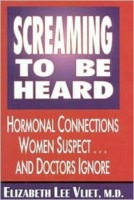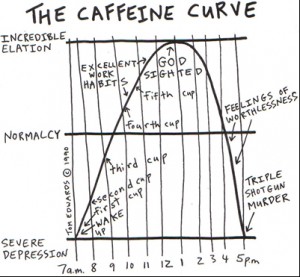Book Review by Terence Gillespie
“The human body has not changed much since its inception, so your foods do not need to change either. Eat the delicious meals of your forebears.”
That simple truth from Eve Gabriel is followed by equally clear guidelines for implementation:OK
“Avoid any food that is advertised on television, radio and magazines. Transition to biodynamic, traditional organic or small diversified farm’s animal foods. Start with the five foods you consume in greatest quantity.”
That’s one truth and a few guidelines covering almost every choice we make about the food entering our bodies. Going further in her new book, The Fateful Fork, Gabriel narrows the fate of our health down to the only food choice that matters: The next one.
“Every mouthful of food you eat presents you with 2 options: To build-up your health, or destroy it. Each bite is a fork in the road: Depending on your choices, you head towards health or disease. Your food leads to predictable destinations.”
Digestible wisdom like this doesn’t come easy. The Fateful Fork is the culmination of a Master’s degree in Naturopathic Nutrition, 15 years of clinical nutrition counseling practice, two decades as a professional chef and a lifetime of research. The vast fields of nutrition, science, food, farming and traditions in health are Gabriel’s life’s work. Her latest book is a condensation of her considerable nutritional wisdom.
The Perfect Diet?
Many of Gabriel’s clients turned to her, as a last resort, to learn which foods to eat and which to avoid to break their reliance on pharmaceutical medications. Although the author initially set out on a journey to find the perfect diet she returned with something better: The knowledge to help others discover what their own optimal diet may be and how to achieve it.
The perfect diet cannot be put on a laminated card and tucked in a universal wallet. It’s a discovery process of what your particular body needs. What can be given to everyone is high quality food and the ability to find, recognize and prepare it. Start with nutrient-dense foods and the optimal ratios for your body will surface naturally if you know how to listen.
Nutrient-Dense Philosophy In One Egg
The criteria for determining nutrient-density is detailed throughout the book. Each criteria forms a level and each level has a range of qualitative possibilities. The basic four levels of quality are:
- Growing Methods.
- Processing Techniques.
- Freshness.
- Preparation Techniques.
The author applies the four levels of quality to an egg:
- Soil – Chickens ought to be eating foods grown in good soil;
- Intact – Eggs are best whole, not just the whites or yolks and not processed;
- Fresh – Not old. Local eggs are best;
- Preparation methods – Many for eggs which are also easy snack and travel foods.
“This boils down to local farm-raised eggs, which are quite easy to come by once you do a little digging in your specific locale.”
Whole and Intact
An important aspect of food that echoes throughout the Fateful Fork is the wisdom of eating foods in their whole form. For instance, lycopene can be isolated from a tomato, but what’s the point? A lycopene pill will never provide the benefits of eating a whole tomato. Applied to an egg that translates into eating the whole egg. No separating the yolk from the white. Protein powders do not supply the nutrient-dense protein of an intact egg delivered by nature in its perfect vessel containing a myriad of other ingredients all in balance with one another.
Nutrient Dense ‘Superfoods’
All this hype about superfoods had me fooled. Our every day food has the potential to be the superfoods we’ve been looking for; from the right source, unprocessed, fresh and well-prepared. As sources become less and less available it’s no wonder the superfood folklore has arisen.
We don’t have to seek out exotic dark chocolates and honey from specialized regions of the world in hopes of being among the lucky few to be blessed with good health. The main staples of our diet are the superfoods we’ve been seeking. The knowledge of recognizing and insisting on them is the holy grail.
The Naturopathic Way
One of the reasons I trust Gabriel’s advice on food is she has a Masters in Nutrition from Bastyr University where the curriculums adhere to the principles of Naturopathic medicine:
- Let nature heal.
- Identify and treat causes.
- First, do no harm.
- Use low-risk procedures and healing compounds.
- When possible, do not suppress symptoms.
- Customize each diagnosis and treatment plan to fit each patient.
- Educate patients.
- Treat the whole person.
- Prevent illness.
Naturopathy builds on the belief that the human body has an innate healing ability. Practitioners craft comprehensive treatment plans that blend the best of modern medical science and traditional natural medical approaches to not only treat disease, but to also restore health.
When my wife and I disagreed with an orthodox medical (Conventional) doctor about the vaccine schedule for our son it was to a naturopathic doctor that we turned. It is serious and wholistic medicine and we’re glad to have a superior alternative to the insurance-dictated conventional. Naturopathic (And Gabriel’s) advice is not given to fit into an insurance reimbursement category. It is customized to individual needs and designed to keep people well. It’s no wonder this comprehensive approach to health is thriving!
Nutrient-Dense Foods Replace Supplements Replacing Drugs
“You can let go of confusing dietary rules and supplement programs, which are only necessary when you eat processed industrial foods.”
Hypertension is a family trait. So far, I’ve been able to control it by non-prescription means. Dr. Atkins Vita-Nutrient Solutions helped me get control of my blood pressure forsaking prescription drugs for a combination of diet, vitamins, minerals and other supplements. After reading The Fateful Fork it’s obvious that many of the supplements recommended by Atkins could be replaced by nutrient-dense foods.
Can I replace all of them? We’ll see. I’m looking forward to trying (With naturopathic assistance). Each pill eliminated is one less expense and hassle even if it’s only a vitamin or herb.
Vegetarian Escapes and Train Wrecks
“If abstaining from animal foods prevented diseases you would know it by now, beyond a shadow of a doubt.”
I think the natural reaction to a juicy steak is to cause the human mouth to water. It’s through disgust, unrelated to the animal itself, that many learn to squelch that natural reaction and turn to vegetarianism to escape. After discovering the disgusting conditions under which animals are grown for the slaughter, injected with hormones and antibiotics and fed unnatural foods to maximize profit it’s inevitable that those same toxicities are delivered onto the dinner plate. How can you blame someone for for trying to escape by going veggie?
Unfortunately, the vegetarian escape leads to another set of problems and, if one is not extremely careful, to a train wreck.
“Eating the grain-based substitutes in place of animal foods is unpleasant and foolhardy. Industrial grains (corn, wheat, rice, barley, and all others, even “ancient grains”) are nutrient-deficient, insulin-triggering, processed foods that continually evolve into ever-stranger renditions as technology changes. . . .They are cheap surplus commodities posing as healthful foods.”
“A side effect of animal product avoidance is rampant deficiencies of fat-soluble vitamins A, D and K. It is not surprising that these are now top-selling supplements. Heart disease, vascular degeneration, cataracts and osteoporosis are some of the consequences of fat-soluble vitamin deficiency.
While reading The Fateful Fork my wife, who had recently ‘gone veggie’, was experiencing many of the above symptoms. A blood test and an appointment with her naturopathic doctor revealed the truth of Gabriel’s words, up close and personal. Vitamin D deficiency, low blood sugar and many other stressful symptoms. The doctors prescription was along the lines of “The Paleo Diet”. There’s much to learn from the metaphor in the Paleo books comparing the modern human diet with that of our ancestors. The Fateful Fork is scientifically consistent with most of the Paleo recommendations but Gabriel’s knowledge is far more comprehensive in addressing every aspect of food.
“Try as they might, the long-term, million-dollar studies funded to prove the health benefits of low-fat vegetarian diets, consistently prove otherwise. Instead, the studies show that carbohydrate-rich diets cause heart disease, diabetes and obesity. The more processed carbohydrates you eat, to the exclusion of animal products, the more likely you are to acquire those diseases, and yet the unsound Federal Nutrition Guidelines are ever more restrictive.”
Avoiding Train Wrecks
The Vegetarian ‘movement’ and desire to escape crummy food may never have happened if the food philosophy and accumulated knowledge put forth in the Fateful Fork was understood and widely adopted. Faced with crummy alternatives people took the path of least resistance: Eating only vegetables and fruits and grains which have the appearance of being fresh and natural.
Contrarianism is catchy. When it comes to industrial foods and the chronic health problems they create it’s hard to resist an idea to do the opposite. Fine, but going veggie is not it. The real escape from industrial foods is to biodynamic, traditional organic or small diversified farm’s animal foods and fresh seasonal fruits and vegetables.
Paleo Plus
The Fateful Fork is what the reader is left hungry for after reading the Paleo diet. If you haven’t read either, yet, you can safely skip Paleo for Gabriel’s book and learn more about every aspect of food in the process. While Paleo backs into proving a metaphor, Gabriel builds every component of a meal from the ground up describing the science, lifestyle, tools and challenges you’ll face from the soil to the dinner plate. Her practical explanations for how to prepare foods that Paleo forbids make for wholistic treatment and a better companion for navigating the vast world of food.
When contemplating grains or legumes, for instance, Paleo just says no. The Fateful Fork tells you the science behind it, how different sources mitigate the downside effects, how preparation affects health values and how it may be combined with other foods to aid digestion.
Raw Milk or No Milk
In The Paleo Diet Cordain says no dairy, period. His reasoning is that “Paleolithic people ate no dairy food. Imagine how difficult it would be to milk a wild animal, even if you could somehow manage to catch one”, he says.
What kind of Paleolithic wimps is Cordain talking about? I can think of a few modern-day engineers, writers and computer programmers who would gladly wrestle a cow into a milk pen to prevent starvation and provide a steady source of food.
In contrast, Gabriel says drink “Raw Milk or No Milk”.
“Raw milk from pasture-fed cows is the ultimate in high-quality food. It is completely different from industrial milk in its composition, freshness and its effects on your health. Historically, raw fresh milk was used therapeutically to cure all sorts of illnesses. The persistent hype in the media, schools, medical field and government about industrial milk’s importance in your diet is based upon the characteristics of traditional raw milk from pasture-fed cows, not on industrial milk. Industrial milk has no redeeming qualities; it ought to be avoided. . . called something else to distinguish it from unadulterated milk.”
And the author does mean raw. Gabriel and her family know the names of the two Jersey cows that produce their milk. Apart from putting it into a bottle the only ‘processing’ is in getting it delivered to the back kitchen door!
Similar advice is given for the forbidden paleo categories of grains and legumes. Gabriel delves further than simple prohibitions based on a metaphor. She provides the science, recommends sources, and gives specific consequences of preparation and combining them with other foods.
Industrial Food, Inc.
“Industrial foods are created to produce one thing: Corporate profits, not healthy people.”
In every area of life, nowadays, we expect technological advances. When it comes to food, however, Gabriel says high-tech innovations are rarely our friend. Technological advances that skirt around quaint notions of high-quality soil-based food may increase corporate profits but only at the expense of human health. The problem is, “You are not periodically updated so that you require new or less nourishment. Despite space travel and cell phones, you are still firmly tethered to this planet earth and the primeval foods it produces. There are no new answers to feeding yourself properly.”
Salt of the Earth, Not the Lab
The real salt of the earth is exactly that: From the earth, not the lab.
“Sea salt contains 92 essential minerals and trace elements such as potassium, magnesium, iodine, boron, selenium, manganese and copper, among others; they do not contain merely sodium and chloride [Like Industrial Table ‘Salt‘].” Even the iodine (Originally added in to prevent goiter –a common thyroid-malfunction-based condition) has become a modern-day ruse with little to no quality iodine in market salts.
Gabriel points out that natural foods don’t have the high amounts of salt we’ve gotten used to. You can add the real salt with more enjoyment and nutrition without fear of adverse effects.
Industrial Food Primer
- NPK Soil Fallacy – Tragically flawed science concluding that only Nitrogen (N), Phosphorus (P) and Potassium (K) was necessary to replenish soil has lead to soil sterility and pollution. The hundreds of nutrients in animal manure and post-harvest plant materials are now dubbed “Waste” and replaced with severely lacking and dangerous NPK ‘fertilizers’. How can you get live foods from dead soil?
- GMO Seeds – Alter the genes of a seed and you own the ‘new’ life-form. These dangerous and unproven altered life-forms convey more property rights than landowners because the patent holders have billions of dollars to enforce them. Farmers have the burden of proof of patent infringement should a scintilla of airborne seed take root in the farmers soil. As this is all but impossible the farmer goes broke just preparing to defend themselves. When they go bust another farm is forced to purchase GMO seeds rather than use the natural seeds from his own crops. Many GMO seeds, once planted, corrupt the soil making the land unsuitable for natural seeds in the future. The farmer landowner is now, in effect, enslaved by the seed provider as is any future purchaser of the land intending to farm.
- Additives – Additives make foods easy to ship, give them a longer shelf life and make them appear the right colors to entice us to buy them. If the label has more than three or four ingredients (Total) you’re probably in trouble. The most benevolent ingredients you can’t pronounce are a lousy attempt to ‘fortify’ the food with something that shouldn’t have been taken out or killed through processing in the first place.
- Protection That Isn’t – Under the guise of protection Amish milk farmers are raided while the FDA claims to lack the authority to intervene in the affairs of industrial meat processors who provide a steadily predictable source of deadly e. coli bacteria. Senate Bill 510 does not protect the public from unsanitary conditions of local farms whose natural approach is routinely pristine; it simply eliminates thousands of local natural food providers producing such high-quality alternatives that industrial food companies cannot compete.
We’re Not Sick, We’re Starving
Many of the supposed diseases– for which we’re told some new pharmaceutical drug is needed— are, in fact, the result of simple nutritional deficiencies.
Healthful ‘lively’ foods contain the enzymes necessary to digest the foods that contain them. Industrial foods are dead on arrival and leech the enzymes necessary for digestion from our bodies. Enzymes, vitamins and minerals are drawn from our bodies quickly causing a dangerous deficit. Ironically, getting ‘supersized’ is an efficient way to literally starve yourself of nutrition. Eating ‘live’ foods with enough enzymes for proper digestion is a complete motivation, in and of itself, to ban industrial dead foods from our diets.
Three Votes Per Day
As overwhelming and powerful as these conglomerates and regulations seem they cannot withstand something much more powerful: The three votes a day each of us may cast in favor of our health. By simply refusing to take empty calories and disease ridden foods into our bodies all the products that disgust will remain unsold and rotting on the pallets that deliver them. That message trumps anything you could put on letterhead or voice mail. It will be delivered loudly and clearly to every food producer and representative in the country with the simple act of lifting a forkful of truly nourishing food to our mouths.
ROrganic!
The word “Organic” is being misused by industrial food processors as a means to sell their disease causing crap. Gabriel recommends a new name for the excellent foods being grown and provided by traditional organic farmers: “Rorganic!” meaning real organic. The author explains . . .
“As with industrial milk — which is so completely different from traditional, raw milk from healthy cows — it ought not to be called “milk” at all; the same is true for USDA Organic.”
“Traditional organic farmers have established their reputation and consumer base due to hard work and long years of persistence. Now that their methods are at last economically viable, traditional organic farmers are suffering from being grouped together with the National Organic Program and its infiltration into a market in which they do not earn a place.”
“Since we cannot seem to stop this federal invasion, the real organic farmers need a new name. Rorganic! seems fitting to me.”
Comprehensive Food Philosophy
Gabriel’s food philosophy is comprehensive and easily digested to cover every area necessary to conduct the food choices for a large family (Or restaurant!):
- Meal Frequency
- Defining a Meal
- The Science of Food
- How to Shop
- Best Sources
- Setting up your kitchen
- Handling snacks
- Food Storage
- Handling Leftovers
- Kitchen Tools
- Social Challenges
- Food Groups Redefined
- Practical Daily-Life Integration
- Money Saving Charts
Reclaiming Delicious
Our bodies are hard-wired to prefer food with high amounts of salt, fat and sugar. Industrial food processors have mastered the trick of including them in almost everything available. Is it any wonder that we’ve lost touch with what the word delicious means?
Delicious is when everything about a food is enticing because it’s what your body needs to live. Media sources would have us believe that means thick-crust pizza, mac ‘n cheese mix, a bag of potato chips and lucky charms for breakfast. Our bodies know that delicious is fresh blueberries and a glass of pure raw milk, wild-alaskan salmon with asparagus, pasture-fed beef and cauliflower, local farm-raised eggs with sprouted bread toast or a handful of pumpkin seeds with a piece of dark chocolate.
Optimal Food Philosophy?
Optimal solutions provide benefits beyond solving the initial problem. They address every dimension rather than merely splitting the difference between a short list of comfortable alternatives. The discovery process screens to match the true context of reality where preconceived notions are, at most, a starting point. The food solutions put forth in Fateful Fork provide the kind of multi-dimensional fruit one would expect from this kind of exhaustive approach to nutrition. They:
- Increase Quality
- Require Less Intake
- Cost less
- Increase Health
- Satiate Appetite
- Realign Imbalances
- Promote Health
- Prevent Disease
- Save Future Health Care Costs
- Are Delicious (The real non-twinky, what your body needs kind of delicious).
The cost is finding sources, sometimes spending more in the short-term, reorienting lifestyle around re-supply and preparation, and abstaining from bad choices.
The author strikes me as someone who has been so immersed in every aspect of her passion about food and nutrition that merely writing about it didn’t make the priority list, until now. Now that it has the reader benefits from Gabriel having faced the challenges of translating and implementing her nutrient-dense philosophy in every conceivable environment, circumstance and context.
If I could choose the experience, qualifications and lifestyle of the optimal person to write about food the theoretical author would have an identical resume to Gabriel’s: A Master’s degree in Naturopathic Nutrition, 15 years of clinical nutrition counseling practice, two decades as a professional chef and an avid gardener. Luckily, we get all that from a person who can also write! What she’s written may enable you to avoid train wrecks and unnecessary health care costs by learning how to load your next fateful fork with the nutrient-dense foods that lead to optimal health.
Copyright © 2010 Terence Gillespie. Permission to reprint in whole or in part is gladly granted, provided full credit and a live link are given to McGillespie.com.







